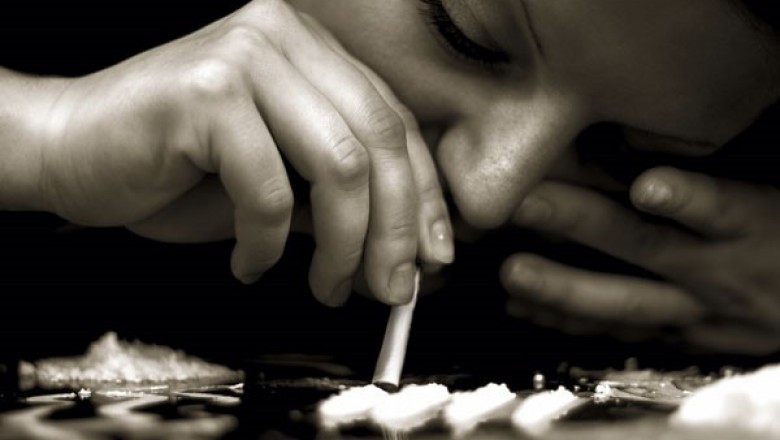views

Addiction: Symptoms, Diagnosis
Cocaine is a drug that makes its users feel stronger, smarter, and safer - no obstacle seems insurmountable anymore. Alcohol tolerance and the sex drive increase after cocaine. This is why some men draw a few “lines” of cocaine before going out with their friends. It becomes problematic when occasional consumption leads to years of dependence, which can lead to impotence and serious health consequences.
No matter what type of cocaine is used; this drug is highly addictive. Even a single consumption can be addictive.
What are the symptoms of cocaine addiction and cocaine withdrawal?
Cocaine is special in that it creates a psychological dependence rather than a physical one. This means that after withdrawal, there are more psychological symptoms that affect the mental state and emotions. Even with a single-use, cocaine causes changes such as increasing tolerance and reactivity. The effects of cocaine wear off quickly, but the desire to feel the effects for as long as possible is enormous.
However, subsequent consumption no longer achieves the same effectiveness. Addicts quickly lose control of their behavior, spend vast amounts of money on their consumption, and slowly reach a state of physical and psychological destruction. Overconsumption is followed by a crash, the stage of a cocaine hangover. Subsequently, the consumer's body and mind demand rest, but the imbalance of the body prevents the addict from sleeping.
This is the cause of persistent mental and physical fatigue, nervousness and impaired ability to concentrate. These symptoms are closely related to an underlying feeling of great threat. The feeling that something terrible is about to happen, that danger is getting closer.
Later phases are characterized by delusions, often related to stalking. Consumers become paranoid, panic checking premises for threats or expect the police to arrest them. You can be confident that you are being monitored, so look for hidden cameras or microphones.
This phase of paranoia is often followed by depression, apathy, and a feeling of insignificance. Food loses its taste, social interaction with friends becomes meaningless, work performance declines and hobbies are neglected because all desire and energy for activities seem to be lost.
Cocaine becomes the only thing that can make the addict happy, and the only motivation to meet up with friends the prospect of drug use again. But two or three days after the cocaine wears off, everything is much more difficult than before. Addicts who do not get cocaine during this time or who try to permanently stop using cocaine are plagued by severe withdrawal symptoms.
What are the negative effects of using cocaine?
Unlike the regular effects of cocaine, these negative effects do not occur in every user. Still, some of these effects can be extremely dangerous to the addict's health. Some effects depend on the specific type of consumption. For example, people who smoke crack have more difficulty breathing. The harmful effects of cocaine can be acute or chronic.
Acute negative effects of cocaine are:
· Hallucinations
· Paranoid delusions
· the feeling of ants crawling over the skin
· Abnormally high body temperature (hyperthermia)
· Significantly increased blood pressure
· Irregular heartbeat (arrhythmia)
· cramps
· Cardiac arrest
Chronic negative effects of cocaine use include the following symptoms, based on the body system involved:
1. Respiratory
Ø Difficulty breathing
Ø Chest pain
Ø Coughing up blood (hemoptysis)
Ø Narrowingof the windpipe
Ø hoarseness
Ø Deviationand degeneration of the nasal septum
2. Cardiovascular
Ø Constricted blood vessels
Ø Increased risk of blood clots (thrombosis)
Ø Heartattack
3. Digestion
Ø Involuntarygrinding of teeth (bruxism), which damages the tooth enamel and can lead to tooth decay and inflammation of the gums
Ø Dry mouth (xerostomia)
Ø dizziness
Ø Abdominal pain
4. Concerning the nervous system
Ø depression
Ø Suicidal ideation
Ø Insomnia or hypersomnia
Ø nightmares
Ø cramps
Ø stroke
5. Concerning the immune system
Cocaine can increase the risk of various autoimmune diseases, such as lupus, glomerulonephritis, Stevens-Johnson syndrome and others.
Treatment of cocaine addiction
Biochemical compensation is the mainstay of the treatment. During this phase, biochemical and neurochemical deficits, as well as physical and neural imbalances caused by cocaine use, are corrected. Psychotherapy and pharmacotherapy are also essential part of treatment, as is a special diet designed after extensive laboratory tests.
During treatment, we encourage family members to participate in the program and provide support to the addict.
When addiction occurs in a family, family relationships become severely stressed. For this reason, we encourage the family to participate in the treatment, as its success depends heavily on family support.
Stages of cocaine addiction treatment
Diagnosis - the initial and significant phase of treatment, during which the physical and mental state of the patient is established. The standard physical examination includes a urine test, tests for hepatitis B and C, for HIV infection and general blood analysis, a biochemical blood analysis, an EKG and an examination by an internist. The standard examination for diagnosing mental health includes a psychodiagnostic (psychological tests that determine the level of dependence and the effects of consumption on the mental health and the patient's health as well Check psychological disorders, possible depression, and the level of motivation for a cure for his addiction). After the diagnosis is made, a team of doctors develops a treatment strategy and plan based on the diagnosis. If risk factors are known or chronic illnesses, additional tests are done and therapy is prescribed.
Psychotherapy - These methods are aimed at treating mental addiction and helping the patient to build defenses against the craving to use cocaine. Therapy is usually carried out individually and - if necessary - in groups.
Aversive therapy helps patients develop a physical aversion to the drug.
Physiotherapy promises excellent results and is available to patients throughout the treatment. It is necessary that the body be restored to the extent that it is able to survive the recovery process. Physiotherapy helps reduce stress and speeds up treatment.
After completing all of these therapies, the patient's constitution and progress made during treatment are assessed. The patient's condition before and after his stay in the drug rehabilitation clinic is analyzed.
Outpatient treatment requires monthly follow-up exams, which are included in the treatment program for one year. In this phase, doctors analyze the patient's condition and adjust therapy if necessary. Patients have the opportunity to ask doctors about anything they are interested in and give their opinion.











